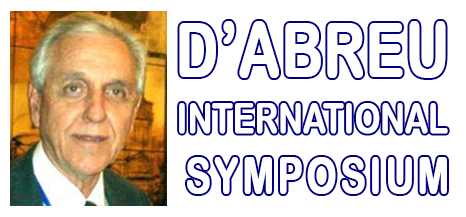List of Accepted Abstracts As of 18/12/2025: (Alphabetical Order)
Summit Plenaries
D'Abreu International Symposium (4th Intl. Symp. on Advanced Sustainable Iron and Steel Making)
Dubois International Symposium (Intl Sympo. on Sustainable Complex Metallic Systems)
Øye International Symposium (Intl Symp. on Sustainable Ionic Liquid and Aluminum Extraction and Processing)
Santilli International Symposium (Intl. Sympo. on Sustainable Mathematics Applications)
Starkey International Symposium (3rd Intl. Symp. on Sustainable Mineral Processing: Principles, Technologies and Industrial Practice)
Yagi International Symposium (2nd Intl. Symp. on Sustainable Metals & Alloys Processing)
Yang International Symposium (3rd Intl. symp. on Multiscale Material Mechanics and Multiphysics and Sustainable Applications)
2nd Intl. Symp. on Advanced Materials and Technologies for
Sustainable Energy and the Environment(AMTSEE)
2nd Intl. Symp. on Multifunctional and Smart Materials, Systems and Structures for Sustainability (MSMSSS)
3rd Intl. Symp. on Sustainable Secondary Battery Manufacturing and Recycling
3rd Intl. Symp. on Sustainable Base-metal Bio-extraction
3rd Intl. Symp. on Sustainable Cement Production
Intl. Symp. World Forum on Sustainable Coal Combustion and Processing
3rd Intl. Symp. on Sustainable Surface and Interface Engineering: Coatings for Extreme Environments
4th Intl. Symp. on Composite, Ceramic and Nano Materials Processing, Characterization and Applications
3rd Intl. Symp. on Sustainable Energy Production: Gas/Oil/Shale; Coal; Nuclear; Waste/Bioprocessing and renewables: wind/waves
5th Intl. Symp. on Environmental, Health, Policy, Legal, Management and Social Issues Related to Metals, Materials and Mineral Processing
3rd Intl. Symp. on Sustainable Production of Ferro-alloys
3rd Intl. Symp. on Sustainable Mining Operations
4th Intl. Symp. on Sustainable Molten Salt and Ionic Liquid Processing
3rd Intl. Symp. on Synthesis and Properties of Nanomaterials for Future Energy Demands
4th Intl. Symp. on Sustainable Non-ferrous Smelting and Hydro/Electrochemical Processing
2nd Intl. Symp. on Physics of Surfaces and Interfaces, from Fundamentals to
Sustainable Applications
4th Intl. Symp. on Quasi-crystals, Metallic Alloys, Composites, Ceramics and Nano Materials
3rd Intl. Symp. on Rare Earth and Platinum Group Metals: Managing and Processing
4th Intl. Symp. on Sustainable Materials Recycling Processes and Products
Intl. Symp. on Rotary Kiln Operations for Sustainable Products
3RD INTL. SYMP. ON SUSTAINABLE SURFACE AND INTERFACE ENGINEERING: COATINGS FOR EXTREME ENVIRONMENTS
Different Type Tin Based Protective Coatings Structures For Aircraft Engine Compressor Blades
P.
Rokicki1 ;T.
Cieciwa1 ;K.
Dychton1 ;M.
Goral1 ;M.
Drajewicz1 ;
1RZESZOW UNIVERSITY OF TECHNOLOGY, RESEARCH AND DEVELOPMENT LABORATORY FOR AEROSPACE MATERIALS, Rzeszow, Poland;
Type of Paper: Invited
Id Paper: 67
Topic: 19Development of modern science and technologies increases demand on used materials. The use of different aircraft engine components and materials structures in aggressive environments or elevated temperature necessitate improvement of existing and development of new materials. They should be characterized by ease of production, high performance and physico-chemical properties. An important role in this field also concerns appropriately selected protective coatings and modification of surface layer that significantly affect the range of applicability. They are designed mainly to improve wear and corrosion resistance in elevated temperature of operation. The tendency in the development of surface layer engineering is thin coatings, based on small range diffusivity and pure coating systems. The development of new types of these materials systems will not only increase the efficiency of conventionally used elements but also introduce a new procedural methodology for the aviation industry. More and more attention in the field is paid to PVD techniques. Presented paper focuses on new types of materials systems obtained with this method. Authors focused their study on the investigation of coatings of TiN, TiAlN and TiCN types and their impact on properties of Titanium Grade 2 as a substrate. These materials are conventionally used for a production of aircraft engine compressors blades and are an excellent example for modification of elements performance parameters. Different coatings obtained on the same substrate allowed investigation of their impact on corrosion, erosion and wear resistance. Additionally, complex microstructure investigation has been performed in meaning to describe the substrate-coating materials system characteristic. Keywords: Blades; Coatings; Corrosion; Steel; Surface; Technology;
Heat-resistant iron-chromium alloys for protective coatings of operating units of power plants
A.
Kandelaki1 ;O.
Mikadze2 ;V.
Garibashvili1 ;G.
Mikadze2 ;Z.
Mirijanashvili1 ;
1FERDINAND TAVADZE INSTITUTE OF METALLURGY AND MATERIALS SCIENCE, Tbilisi, Georgia; 2GEORGIAN TECHNICAL UNIVERSITY, Tbilisi, Georgia;
Type of Paper: Regular
Id Paper: 77
Topic: 19Intensive progress of the various modern technologies (aeronautics, space exploration, nuclear energy, etc.) causes the need for the new structural materials operating in extreme conditions (high temperatures, aggressive media, high mechanical loads, etc.). However, the practice shows that tailoring of materials with the combination of all required properties is a rather hard task. As a result, the technique of coating used to protect refractory matrix from corrosion- and wear resistance, radiation, etc. acquires special relevance.
As a material for protective coating of heat-resistant matrices there was selected a high-chromium alloy (Fe-45%Cr-4% Al) doped with the rare earth metals (0.25% La or Y) [Georgian Patent, P 3273, 24.06.2002, O.Mikadze, E.Kutelia et al.].
Reliable protection of matrix is provided by a formed Al2O3 layer at the interface of phases – the coating- matrix . It is important that this layer remained stable under harsh conditions of operating unit (high temperatures, cyclic loading, etc.): remains entirely solid and should not exfoliate upon cooling. These requirements are satisfied after doping of the coating material with rare earth metals.
In the present work, for similar purposes, the authors offer an iron-chromium alloy (up to 16% Cr) doped with Zr and Ce (Fe-16%Cr-5,0%Al-0,5%Zr -0,3%Ce). Adding of Ce changes the mechanism of formation of the protective oxide (Al2O3) layer at the coating – matrix interface, resulting in the improved properties (adhesion, abrasion resistance, strength characteristics, etc.).
Positive influence of Ce on the formation of a protective oxide (Al2O3) layer is enhanced by its co-doping with Zr. Here an economic aspect of the technology is important factor - it is significantly cheaper. The reduced chromium content (to 16%) makes it possible to provide air melting under flux and fabricate the product easy to forge, roll and process by cutting. Keywords: Alloys; Coatings; Corrosion; Heat; HighTemperature; Surface; Technology; Wear;
Inverstigation on the microstructure and Properties of Chemical Plating Ni-P and Ni-W-P
C.
Bao1 ;
1SHENYANG BLOWER WORKS GROUP COMPANY, Dalian, China;
Type of Paper: Regular
Id Paper: 105
Topic: 19X-ray diffraction, optical microscope , Electron-chemical station, hardness tester and etc. were used for the microstructure, combination force, hardness and corrosion resistance properties investigation on the produced with Ni-P and Ni-W-P electroless plating coatings as coated and after heat treatments. The results show that the combination of both kinds of coating with the substrate is good and coatings are with uniform thickness. The coating shows well packed homogenous cells with a certain direction, and with low porosity. Ni-W-P coating starts to crystallize with lower heat treatment temperature. Ni-W-P coating presents better ductility than Ni-P, when the hardness of the coating is higher than 800HV. As well, Ni-W-P coating shows better anticorrosion property under certain corrosive service state. Keywords: Blades; Coatings; Industry; Steel; Wear;
Size-dependent behaviors of Kirchhoff microplate with surface stress and surface induced residual stresses
Y.
Yue1 ;
1SHANGHAI UNIVERSTIY, Shanghai, China;
Type of Paper: Invited
Id Paper: 320
Topic: 19A new Kirchhoff microplate model with surface effect is developed by using simplified strain gradient elasticity theory and surface elasticity theory. This new model can be used to describe size-dependent behaviors and surface effects. Different from others plate models, our present model contains surface induced residual stresses which are induced by initial surface stress to balance the plate. Based on whether the plates having surface induced residual stress or not, their governing equations have a distinct difference. The new plate model is applied to analyze the size-dependent behaviors of simply supported Kirchhoff microplate. And how the initial surface stress affects the response of Kirchhoff microplate is also studied. As the surface induced residual stresses are generally neglected in the existing research, the influence of surface induced internal residual stresses is mainly explored. The numerical results reflect that when the simply supported microplates do not have surface induced residual stresses, internal length scale and surface stress have a significant influence on the deflection of the microplates. However, when the simply supported microplates have nonzero surface induced residual stresses, the effects of internal length scale and surface stress are very weak. Keywords: Surface;
« Back To Technical Program
|



